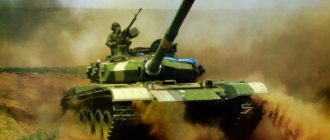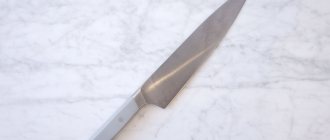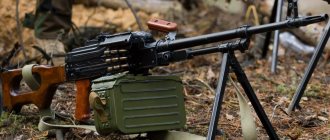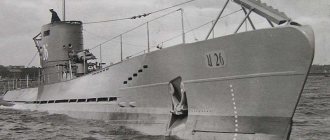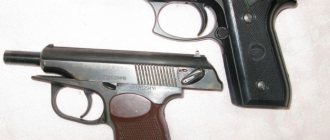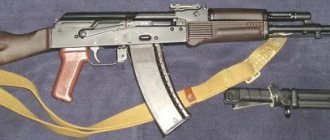Russian Marine Knives
Units of the Russian Navy are supplied with sets of knives for various purposes. Certain types of products are used by divers, rescuers, ship crew members, and coastal military personnel. There are models designed for hand-to-hand combat, for performing repairs and other work.
Utility diving knife
Both working and combat models are provided for divers. The utility diving knife was created in the late 1970s, but is still in demand. This is a convenient working tool for divers; it can be used to cut, pierce, crush, and saw materials of different densities. The product is also suitable for combat purposes.
The universal marine knife has a plastic sheath with a ring-shaped rubber holder. They have two fastenings for fixing on diving equipment.
The length of the knife is 32 cm, the blade is 16.4 cm. The blade is made of stainless steel or diamagnetic. It is sharpened in a one-and-a-half way, the sharp end allows for piercing blows. The butt is serrated type, that is, sharpened in a wave-like manner. The spindle-shaped plastic handle has a cross guard that protects the palm, and the specially shaped back edge can be used as a hammer.
Diving knife from KAMPO
The knife belongs to the SVU-5 diving equipment used in the Russian Navy. The product, measuring 35.3 cm, is equipped with a blade 18.5 cm long and 4 cm wide made of steel grades 100x13M or 95x18, its end has the shape of a chisel, and one of the side surfaces is engraved with a measuring ruler. Weight is 700 g. The butt is 6.2 mm thick and sharpened in the shape of a file.
Marine utility knife
It belongs to the so-called folding-type boatswain working models. . The marine utility knife consists of 3 working elements. Two blades of different shapes are attached to one edge of the handle: a short one with a stripper and a long universal one. On the other edge there is a pile for ropes. The sea blade from KAMPO is a new model, similar to the old boatswain's products, but characterized by greater ergonomics and design improvements.
Composite "Moray eel"
The model is designed for anti-sabotage units and military divers protecting seaports and structures from underwater attacks of a possible enemy. The customer was the Russian Navy, and the production was carried out by the SN SARO enterprise. The result is a knife with a blade 5.4 mm thick, easily cutting metal barriers up to 1.5 cm thick. The blade is made of 65×13 stainless steel.
"Needle" and its sheath
This naval knife, like the previous one, is part of the armament of anti-sabotage units. It is a multifunctional military product that allows you to cut, open, chop, and perform other manipulations on various materials. Manufacturer: Kazan.
“Needle” is a complex product, the numerous functions of which are performed not only by the blade, but by a sheath designed in a special way.
The total length is 31.9 cm. Blade length is 17.3 cm, thickness is 5 mm, width is 3.5 cm. The stainless steel blade with a hardness of HRC = 52-56 units is sharpened using the one-and-a-half method and has a sharp end. The butt is serrated with a 10-centimeter ruler. The crosspiece is supplemented with a recess for cutting wire.
The sheath is plastic with metal elements. They are equipped with an awl, a hacksaw, wire cutters and a screwdriver. A fabric cover is provided with which the sheathed weapon is attached to the ammunition.
Application
The boatswain's knife was not a means of sorting out relations between sailors. He was a real helper in sea life. The direct purpose of the knife is to cut ropes and separate them into their component parts.
The last operation was very convenient to perform using a pile. It was specially rounded for ease of operations.
With the help of a pile it was possible to untangle tricky sea knots. Such a knife could also be useful as a corkscrew.
As you know, sailors were very fond of rum. In fairness, it should be said that such capabilities of the knife appeared only after the ban on fixed blades. The product fit comfortably in a pocket. To use it, it had to be decomposed.
Marine knives from other countries
There are manufacturers of sailor's knives in many countries. Military personnel of all states that go to the sea must have this equipment. Marines use knives for hand-to-hand combat as a work tool and a means to help them survive in emergency situations.
The most popular imported models are American-made. The most popular products around the world are Scuba Max Titanium and Ka-Bar products.
Consider the popular combat models made in the USA:
- Scuba Max Titanium is used by Marine Corps swimmers. The length of the product is 20.8 cm, the blade is 10.5 cm. The blade is made of a compound of titanium and beryllium, and has a recess for slings. The butt is serrated. The handle is complemented by a relief for the fingers, and a guard is provided to protect the palm.
- The legendary Ka-Bar marine knife was used during World War II. The length of the product is 29.8 cm, the blade is 17.8 cm. The blade and guard are steel, the handle is leather.
- Ontario Mk.3 Mod.0 Navy Seal Knife features a thin blade with a 2-sided sharpening, one of its edges is serrated. The guard is steel, straight. The handle is figured, plastic. Its dorsal edge is flattened and strong, used as a hammer.
- The Mission MPK with a titanium blade is used by special units of the US Navy. The blade is not sharp and is intended for neutralizing mines with a magnetic explosive device. The length of the weapon is 30.5 cm, the length of the blade is 16.5 cm. The butt is embossed, the blade is partially serrated.
- The SOC Trident knife is 27.9 cm long, the blade is 16.3 cm. The handle is symmetrically convex, the guard is steel. The back edge of the handle is large and serves as a glass breaker.
- The Benchmade Marc Lee Glory 150BKSN is a weapon produced in memory of fallen Marine Mark Alan Lee. The total length is 31.8 cm, the blade is 18.5 cm. The handle has a curved shape and a recess for the finger; there is no limiting element. The corrosion-resistant blade is engraved with the US Navy emblem and the date of Alan Lee's death.
knives intended for work purposes, one should name the semi-automatic Spyderco Clipitool Rescue and Kershaw Barricade Flipper , the Benchmade Presidio Auto 5000 SBK , as well as mechanical models - the American SOC Nautical and the German Böker Plus Savior . The best options for fishermen, divers, and yacht owners are the Ontario Mk .3 Mod .0 Navy Seal Knife and SOG Trident .
Modern replicas
Currently, boatswain's knives have undergone some changes since the old days. Classic models are almost never produced anywhere. But still, some sailors use such knives. Unique items still remain in conservation warehouses.
Sometimes they are written off and put on sale. But the classic boatswain's knife has been replaced by modern products and replicas of the past. The most popular among them are the following products:
- from the American there is the “Offshore System” set;
- there is a modern replica from the Vorsma company;
- a wonderful product - a Swiss yacht knife, it is called “Alinghi 176”;
- from the Knox company, the product is called - boatswain.
Today you rarely meet a yachtsman who goes on a long voyage. Mostly these knives end up in collections. But still, there are people who use a boatswain’s knife for its intended purpose.
Royal gifts
Years passed, and the tradition of donating weapons and armor only developed. And the award weapons themselves acquired distinctive features and a special status. But how did it come to this? After all, until the 18th century there was no need to talk about any unification of award weapons.
Broadsword by Mikhail Skopin-Shuisky
One of the first confirmed and interesting examples of such a gift is the armor donated by Emperor Ivan the Terrible to the famous Cossack Ermak Timofeevich in 1583 - a heavy gilded shell with an eagle on the chest. By the way, perhaps it was this gift, intended for protection, that caused the death of the famous chieftain, dragging him to the bottom of the Irtysh.
The next example can be considered the remarkably preserved broadsword of one of the best Russian commanders of the Time of Troubles, Mikhail Skopin-Shuisky, in the exhibition of the State Historical Museum. Richly decorated with silver, ornaments and precious stones with pearls, the blade looks very impressive. The blade was presented to the commander for the victory over the troops of the “Tushino thief” of False Dmitry II.
Another exhibit of the State Historical Museum is the saber of the savior of Russia, Prince Dmitry Pozharsky. Most likely, the saber was given to the prince by city residents who were grateful for the liberation of Moscow from the Poles. Richly decorated with silver and gold chasing, with precious stones, the Persian damask saber bears traces of battles. This proves that in those days, award weapons were used for their intended purpose, and not just worn for beauty.
Saber of Prince Dmitry Pozharsky
A little later, during the reign of the first Romanovs - Mikhail Fedorovich and Alexei Mikhailovich - dedicatory inscriptions appeared on weapons. For example, “the sovereign autocrat granted Peter Petrov, the son of Zhadovsky,” says the inscription on the saber of the steward Zhadovsky. Many princes from eminent families, such as the Golitsyns, Skuratovs, Dolgorukovs, and others, were awarded “registered” sabers. But the true history of regulated award weapons begins in the 18th century.
At the same time, the tradition of giving award firearms arose. Thus, Ataman F. Minaev received from the Armory a arquebus with an apple tree stock decorated with bone and mother-of-pearl.
Throwing weapon
This weapon is a special subtype of cold weapon. It is not in vain that it is allocated to a separate subgroup. The fact is that it helps the owner, who knows how to handle it, to hit a target at a distance, using only muscular effort and accuracy skills. It is often used in hunting. Typically, throwing knives or darts are used. There are also more exotic types, such as shurikens, spears, boomerangs, and crossbows. The latter name, along with onion, pilum and sulitsa, was used by ancient Slavic and Roman warriors. Today this type of weapon has remained mainly in sporting use.
Special mention needs to be made about shuriken, as the iconic weapon of Japanese warriors. Contrary to the ingrained stereotype, it was used not only by ninjas, but also by other warriors in the Land of the Rising Sun. There are an unimaginable variety of them, and the variety of forms is amazing. The samurai perfected the use of shurikens: they can be used to cut, toss unnoticed at a target, and to stab. It was because of the secret murder that shuriken gained the reputation of being so-called invisible.
Comments
Comment by Flucllo
Part of the Garrison Support questline.
| Garrison Campaign: War Council | Alliance: Garrison Campaign: War Council | Horde: Garrison Campaign: War Council |
| We Need a Shipwright | Alliance: We need a shipbuilder | Horde: We need a shipbuilder |
| Derailment | Alliance: Derailment | Horde: Derailment |
| The Train Gang | Alliance: Train Raid | Horde: Train Raid |
| Hook, Line, and... Sink Him! | Alliance: Hooked! | Horde: I'm hooked! |
| Nothing Remains | Alliance: And there's nothing left | Horde: And there's nothing left |
| All Hands on Deck | Alliance: All hands on deck | Horde: All hands on deck |
| Let's Get to Work | Alliance: Let's get to work! | Horde: Let's get to work! |
| Shipbuilding | Alliance: Ship Construction | Horde: Ship Construction |
| Strange Tools | Alliance: Strange Tools | (no Horde equivalent) |
| Ship Shape | Alliance: All hands on deck! | Horde: Call everyone upstairs! |
| The Invasion of Tanaan | Alliance: Invasion of Tanaan | Horde: Invasion of Tanaan |
| Obstacle Course | Alliance: Obstacle Course | Horde: Obstacle Course |
| In, Through, and Beyond! | Alliance: Faster, higher, stronger! | Horde: Faster, higher, stronger! |
| The Assault Base | Alliance: Base of Operations | Horde: Base of Operations |
| Shipyard Report | Alliance: Report from the pier | Horde: Report from the pier |
| Naval Commander | Alliance: Secrets of Navigation | Horde: Secrets of Navigation |
| Destroying the Competition | Alliance: Destruction of competitors | Horde: Destruction of competitors |
| Upgrading The Fleet | Alliance: Fleet Re-equipment | Horde: Fleet Re-equipment |
This quest teaches you how to build a ship.Starting with Solog Roark, ask him to build a transport.It takes a minute for this ship to build at which point take itSpeak with Solog Roark to end the quest.
Comment by Taramina
If you're not one of those who like to get their instructions from videos and haven't already figured it out, the shipyard is not built by using your command table. Exit your garrison at the gate that's near your Menagerie and leads out to the snowy area towards the shore. You will see an NPC along the road who will direct you where to go to get construction started.
Comment by yoco68
If nothing happens after talking to Roark, log out and back in again.After I did that, commanding Roark to build the ship actually popped up a window that allowed me to build it.
Sailor's or boatswain's?
In addition to the usual sea knife, on the pages of various kinds of novels you can also find the so-called “boatswain’s knife.” Logically, since the boatswain is no longer an ordinary sailor, but, after all, a junior command staff, then his knife should be different from the knife of an ordinary sailor. But alas and ah. There is a trick here of a purely linguistic nature. The fact is that as the sailing fleet began to lose ground, the sailor's knife migrated to lifeboats as equipment. Or, if you prefer, a sea survival knife. And it began to be called not a sailor, but a boat. From time to time, the inventory was written off, which was most often done by the boatswains. Many people took knives for themselves - hence the name. But few people know about this, which is why many knife collectors have come across the fact that a sailor knife was sold to them at a significant premium to the real cost (presumably for the title of the owner). We sincerely wish you not to fall for this bait!

